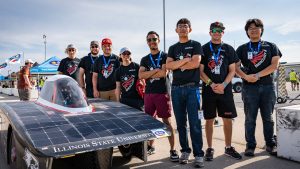ISU Solar Car Team powered by patience, persistence
By Ken Keenan for Chronicle Media — October 10, 2023
The Illinois State University Solar Car Team competed in the ASC-sponsored Electrek Formula Sun Grand Prix, held in Topeka, Kansas, from June 27 to July 1, and earned a third-place finish. (Photo courtesy of the Illinois State University Solar Car Team)
In the classic fable, “The Tortoise and The Hare,” the moral of the story is that one can be more successful by doing things slowly and steadily than by acting quickly and carelessly.
That philosophy pretty much underlines the modus operandi of the Illinois State University Solar Car Team, a student-led organization that designs, builds and races solar vehicles. The stated goal of the team is to design and construct a solar-powered car — according to the latest set of regulations provided by the American Solar Challenge — and then race the vehicle during the ASC’s cross-country race, held every two years, and a grand prix race, held annually.
This year, the ISU team competed in the ASC-sponsored Electrek Formula Sun Grand Prix, held in Topeka, Kansas, from June 27 to July 1, and earned a third-place finish. The event, held on a three-mile, grand prix (or road-style) closed course is designed to test the limits of solar cars in handling curves, braking and acceleration.
“It’s a long endurance race,” said Jim Dunham, shop adviser for the ISU team since its inception, in 2005. “It runs eight hours a day for three days, and the team with the most laps wins. You have to go through a lot of inspections, and there are safety rules and design requirements. These are fairly sophisticated vehicles, and they’re all built by students — all on their own free time.”
The 2023 team includes Kruz Barrera, Shane Burke, Matt Hauptman, Mike Smith, Shaun Nayahangan, Suhail Pradip Tailor, Michelle VanGeertry, Emma Burns, Russel Roberts, Bryson Wetzler, Collin Maguire, Alex Helderman and Keegan Baisa.
Dunham said the design process for a solar car, made out of carbon fiber, takes six months or more to complete. The process is almost entirely virtual, and includes numerous steps along the way.
“A lot of engineering parameters go into it,” Dunham said. “First, you have to ‘weight’ it correctly. You want two-thirds of the weight on the front axle. You have to be able to tilt 45 degrees so it doesn’t tip over. With the solar panels, you want a dead, flat surface. The solar panel provides the most energy, and when it’s perpendicular to the sun, you get more energy that way. Every 10 degrees that it’s not perpendicular, the less power the solar panels produce.”
Dunham continued: “It’s a balancing act. For aerodynamics, you want a skinny car. For stability, you want a wider car so it doesn’t spin out. These cars are 40 inches wide and 15 feet long, so they’re kinda tippy. You’re trading stability for drag. The lighter the car, the less the motor has to work to power the car. But if the car is too light, stability becomes a problem. It’s an amazing design challenge … a big pile of compromises.”
For members of the ISU Solar Car Team, that’s all part of the deal.
“When the students are building something complicated, working as a group, you learn a lot,” Dunham said. “You’re building a car from scratch, passing inspections, and then keeping it on the track. It’s a lot different from classroom learning. It’s real-world experience … real-world problem solving. The kids who put in the time get a tremendous amount out of this. It’s really impressive, the commitment shown by these students.”
After all, as the tortoise taught the hare, slow and steady wins the race.







